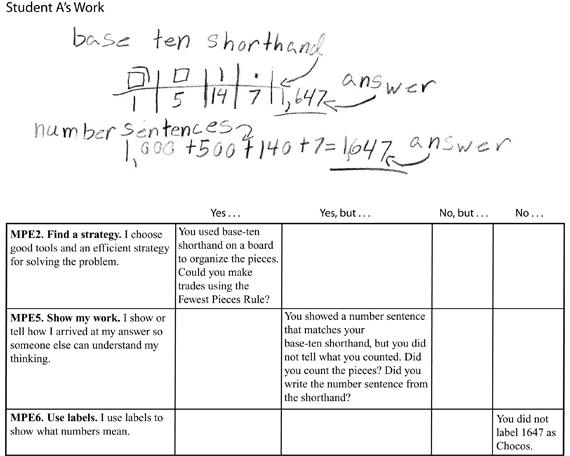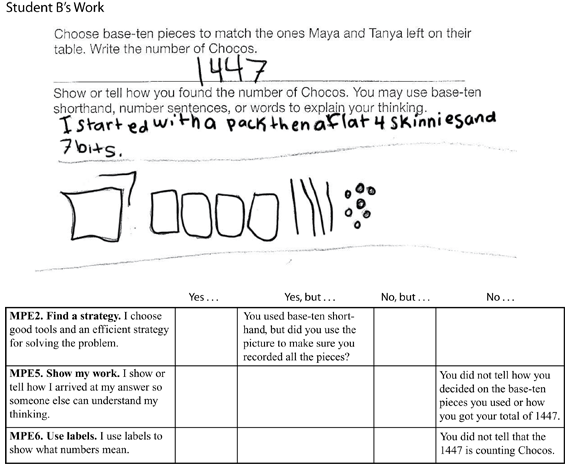Discuss and Solve Using Math Practices.
As students think about the TIMS Candy Company, ask:
- Why do you think the company uses the Fewest Pieces Rule to package their Chocos? What are the advantages? (Possible responses: The Fewest Pieces Rule means you have to package the candy into the fewest packages. It is easier to handle 1 flat of candy than 10 skinnies. One package of 1000 Chocos is easier to work with than 1000 little bits. Or, you can easily tell how many Chocos are in an order. The number of packages tells the way to write the digits in the total number.)
Tell students that they will show how to count and group Chocos shortly. Use the Math Practices page in the Student Guide Reference section to discuss Expectations for showing and labeling their work and finding a strategy when counting Chocos.
Display the Math Practices page, refer to Math Practice 2, and ask:
- What tools can you use to show how to group (partition) and count Chocos? (words, base-ten pieces or shorthand, number sentences, and tables like the Base-Ten Recording Sheet)
- What are some strategies you can use to count a large number of Chocos? (making trades to find the fewest pieces, or grouping the different types of partitions (e.g., skinnies) and then putting the groups together)
Refer to Math Practice 5 and ask:
- What should you write down? (show the tools used, tell how counting was organized, show the number of Chocos, write a number sentence or skip counting to show how Chocos were put together)
Refer to Math Practice 6 and ask:
- What labels should you use when counting Chocos? (Students may include Chocos, bits, skinnies, packs, flats, and base-ten pieces.)
Distribute and ask students to complete the How Many Chocos? Assessment Master. Remind them to keep these Expectations in mind as they work. Have copies of the Base-Ten Recording Sheets 1 Master available for students who want them.
The problem on the How Many Chocos? Assessment Master can be adjusted based on students' skills:
- Use 5 flats, 14 skinnies, and 7 bits for students who need to work with a smaller number of places in the number.
- Use 1 pack, 12 flats, 14 skinnies, and 7 bits to challenge students with a set of pieces that requires two trades to show the fewest pieces.
Review Sample Work. When students have completed their work, review samples of student work with the class. Display samples from the Student A's Work, Student B's Work, and Student C's Work Masters. Point out to students that they should be able to follow the steps to solve the problem in the same way shown on each work sample.
You can replace the sample student work with appropriate work from your class.
Ask students to work in groups. Distribute copies of the Masters. Assign one sample of student work to each group so that each work sample is evaluated by at least two groups. Ask each group to fill out the Feedback Box on the bottom of their assigned work sample.

Use the How Many Chocos? Assessment Master with the Feedback Box to assess students' development of place value concepts to the thousands. Note students' progress toward the Expectations and Math Practices Expectations below:
- Represent numbers (to the thousands) using base-ten pieces, words, and symbols [E1].
- Compose and decompose numbers using ones, tens, hundreds, and thousands [E2].
- Show different partitions of numbers using base-ten pieces and number sentences [E3].
- Recognize that different partitions of a number have the same total (e.g., 100 + 20 + 3 = 100 + 10 + 13) [E4].
- Read and write large numbers (to the thousands) [E5].
- MPE2.
- Find a strategy. I choose good tools and an efficient strategy for solving the problem.
- MPE5.
- Show my work. I show or tell how I arrived at my answer so someone else can understand my thinking.
- MPE6.
- Use labels. I use labels to show what numbers mean.
Make a Pack or Make a Flat games can be used for targeted practice.
Lesson 6 Workshop: Place Value also provides targeted practice.
Sample completed Feedback Boxes are shown in Figures 5, 6, and 7.
Ask groups to report the following to the class:
- Is the student work clear enough so you know what strategy was used to solve this problem? If so, explain the strategy that was used. If not, tell what else you need to know to be able to solve the problem using the same solution.
- Explain what you said about the student's work in the Feedback Box.
Discuss any discrepancies that arise between student groups that reviewed the same student work sample.


















